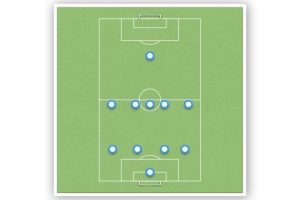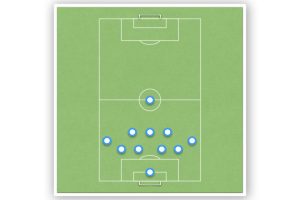A Tactical Breakdown of the Classic 4-1-4-1 Formation: Understanding the Key Elements
The 4-1-4-1 formation is a classic tactical setup that has been used by some of the most successful teams in the world. This formation is known for its flexibility and adaptability, allowing teams to adjust their strategies based on the strengths and weaknesses of their opponents. In this article, I will provide a tactical breakdown of the 4-1-4-1 formation, including key positions and roles, tactical flexibility, strengths and weaknesses, and famous adaptations.
Understanding the 4-1-4-1 formation is crucial for any coach who wants to build a successful team. This formation is characterized by a single striker upfront, supported by four midfielders and a defensive midfielder. The defensive midfielder plays a critical role in the formation, providing cover for the backline and helping to transition the ball from defense to attack. The four midfielders are responsible for creating chances and supporting the lone striker, while the backline provides defensive stability.
One of the key strengths of the 4-1-4-1 formation is its tactical flexibility and variation. This formation can easily adjust to a range of other formations, such as a 4-4-2, 4-3-3, or 4-1-3-2, giving coaches the ability to switch strategies mid-game. Additionally, the 4-1-4-1 formation allows for a strong defensive block, making it difficult for opponents to break down. However, this formation can also be vulnerable to counterattacks, and requires disciplined defending from the midfielders and backline.
Key Takeaways
- The 4-1-4-1 formation is a classic tactical setup known for its flexibility and adaptability.
- Key positions include a single striker supported by four midfielders and a defensive midfielder.
- The formation’s strengths include tactical flexibility and a strong defensive block, while its weaknesses include vulnerability to counterattacks and the need for disciplined defending.
Understanding the 4-1-4-1 Formation
I have found that the 4-1-4-1 formation is a great option for teams looking to balance defense and offense. This formation is a variation of the popular 4-4-2 formation, but with a lone striker supported by a split midfield. The defensive midfielder provides extra cover for the back line, allowing the team to defend in numbers while the attacking midfielders provide creativity and support for the striker.
Let’s take a closer look at the player positions in the 4-1-4-1 formation:
Player Positions
Goalkeeper (GK) – The goalkeeper is the last line of defense and is responsible for stopping shots on goal.
Left-Back (LB) and Right-Back (RB) – The full-backs play on either side of the central defenders and are responsible for defending against opposing wingers.
Center-Backs (CB) – The central defenders are responsible for marking opposing strikers and clearing the ball out of danger.
Defensive Midfielder (DM) – The defensive midfielder is responsible for protecting the back line and breaking up opposing attacks.
Left Midfielder (LM) and Right Midfielder (RM) – The wide midfielders provide width to the team’s attack and are responsible for tracking back to defend.
Central Midfielders (CM) – The central midfielders are responsible for linking defense and attack, providing support to the lone striker, and creating chances.
Striker (ST) – The lone striker is responsible for scoring goals and holding up play to bring the midfielders into the attack.
Strengths and Weaknesses
Like any formation, the 4-1-4-1 has its strengths and weaknesses. Here are a few to keep in mind:
Strengths
Solid defensive base: With a defensive midfielder in front of the back line, the team can defend in numbers and limit the opposition’s chances.
Creative attack: The split midfield allows for more creativity in attack, with the central midfielders able to support the lone striker while the wide midfielders provide width.
Flexibility: The 4-1-4-1 can be adapted to suit the team’s strengths and weaknesses, with the central attacking midfielder able to drop back and help defend or push forward to support the striker.
Weaknesses
Vulnerable to counter-attacks: With only one striker, the team may struggle to get back quickly enough to defend counter-attacks.
Lack of width: While the wide midfielders provide some width, the team may struggle to stretch the opposition’s defense and create space.
Reliance on the lone striker: If the lone striker is marked out of the game, the team may struggle to create chances and score goals.
Overall, the 4-1-4-1 formation can be a great option for teams looking to balance defense and offense. With a solid defensive base and a creative attack, this formation can be adapted to suit the team’s strengths and weaknesses.
Key Positions and Roles
As a coach, I believe that the 4-1-4-1 formation is one of the most flexible formations in soccer. It provides a solid defensive base while also allowing for creativity and flexibility in attack. In this section, I will break down the key positions and roles in the 4-1-4-1 formation.
Goalkeeper and Defenders
The goalkeeper is the last line of defense in the 4-1-4-1 formation. Their job is to organize and communicate with the defenders to ensure that the back line stays organized and compact. The center backs are typically the most important defenders in the formation, as they provide the foundation for the defensive structure. They must be strong in the air, good at tackling, and able to read the game well.
Defensive Midfielder
The defensive midfielder is the anchor of the team in the 4-1-4-1 formation. Their primary role is to protect the back line and break up opposition attacks. They must be strong in the tackle, good at intercepting passes, and able to read the game well. The holding midfielder should also be comfortable on the ball and able to distribute it effectively to the central midfielders.
Central Midfielders
The central midfielders in the 4-1-4-1 formation are responsible for linking defense and attack. They must be comfortable on the ball, able to play short and long passes, and able to create chances for the lone striker. The central midfielders must also be willing to track back and defend when necessary.
Wide Midfielders
The wide midfielders in the 4-1-4-1 formation are responsible for providing width and stretching the opposition defense. They must be quick, skillful, and able to beat defenders in one-on-one situations. The wide midfielders must also be willing to track back and defend when necessary.
Striker
The lone striker in the 4-1-4-1 formation is responsible for leading the attack and scoring goals. They must be strong, quick, and able to hold up the ball to bring the central midfielders into play. The striker must also be willing to press the opposition defenders and track back to defend when necessary.
Overall, the 4-1-4-1 formation requires a high level of teamwork and discipline from all players on the field. Each player must understand their role and work together to achieve the team’s goals.
Tactical Flexibility and Variation
The 4-1-4-1 formation is a great example of a formation that offers a lot of tactical flexibility and variation. With just a few simple swaps of players, the 4-1-4-1 can be transformed into other formations, such as the 4-3-3 or the 4-2-3-1. This allows teams to quickly adapt to changes made by opposition sides and to take advantage of different strengths and weaknesses.
From 4-1-4-1 to 4-3-3
One of the most common variations of the 4-1-4-1 formation is the 4-3-3. This formation is similar to the 4-1-4-1, but with a few key differences. In the 4-3-3, the two wide midfielders push up higher on the field, creating a more attacking formation. The central midfielder drops back to provide support to the lone defensive midfielder. This formation is great for teams that want to focus on wing-play and the collaboration of the midfield triangle.
To switch from the 4-1-4-1 to the 4-3-3, simply move the two wide midfielders forward and drop the central midfielder back. This can be done quickly and easily during a game, allowing teams to take advantage of different situations on the field.
From 4-1-4-1 to 4-2-3-1
Another popular variation of the 4-1-4-1 is the 4-2-3-1 formation. This formation is similar to the 4-1-4-1, but with two defensive midfielders instead of one. This provides extra support for the defense and allows the team to play a more possession-based game.
To switch from the 4-1-4-1 to the 4-2-3-1, simply add another defensive midfielder to the formation. This can be done by moving one of the central midfielders back or by bringing on a substitute.
Overall, the 4-1-4-1 formation offers a lot of tactical flexibility and variation. With just a few simple changes, it can be transformed into other formations, such as the 4-3-3 or the 4-2-3-1. This allows teams to adapt to different situations on the field and to take advantage of different strengths and weaknesses. As a coach, I highly recommend the 4-1-4-1 formation for teams that want to play a possession-based game and focus on tactical flexibility.
Strengths and Advantages of 4-1-4-1
One of the main advantages of this formation is its defensive stability. The presence of a defensive midfielder provides an extra layer of protection to the back line, allowing the team to defend in numbers and limit the opposition’s chances. This can be especially useful when playing against possession-based teams that rely on quick, short passes to break down defenses.
In addition to its defensive stability, the 4-1-4-1 formation also offers good attacking potential. The split midfield allows for more creativity in attack, with the central midfielders able to support the lone striker while also maintaining a strong defensive shape. This can be especially effective when playing against teams that tend to sit back and defend in numbers, as it provides more options for breaking down their defense.
Another advantage of the 4-1-4-1 formation is its fluidity. The formation can easily adjust to a range of other formations, such as a 4-4-2 or a 4-3-3, depending on the situation. This gives teams a serious dynamic, enabling them to switch strategies mid-game and keep their opponents guessing.
Finally, the 4-1-4-1 formation is well-suited for possession-based teams. The split midfield allows for more passing options, making it easier to maintain possession and control the tempo of the game. This can be especially useful when playing against teams that like to press high up the field, as it allows for more options to play out from the back.
Overall, the 4-1-4-1 formation provides a solid defensive base, while also offering good attacking potential, fluidity, and suitability for possession-based teams. As a coach, I have found this formation to be a reliable and effective choice for many different types of teams and situations.
Weaknesses and Disadvantages of 4-1-4-1
I have found that the 4-1-4-1 formation has some weaknesses and disadvantages that need to be addressed. One of the biggest disadvantages of this formation is the risk of being overrun in midfield. With only one defensive midfielder, the opposition can quickly overload the central midfield and create scoring chances. This means that the defensive midfielder must be disciplined and positionally aware to prevent the opposition from taking advantage of the space in midfield.
Another weakness of the 4-1-4-1 formation is that it can be difficult to create scoring opportunities. The lone striker can become isolated if the midfielders are unable to provide adequate support. This can lead to a lack of creativity and a reliance on long balls to the striker, which can be easily defended by the opposition.
Furthermore, the 4-1-4-1 formation can be vulnerable to counterattacks. The attacking fullbacks and wingers can leave gaps in the defense, which can be exploited by the opposition. This means that the fullbacks and wingers must be disciplined and aware of their defensive responsibilities.
In addition, the 4-1-4-1 formation can be inflexible in certain situations. For example, if the team needs to score a goal late in the game, it can be difficult to switch to a more attacking formation without sacrificing defensive stability.
Overall, while the 4-1-4-1 formation has its strengths, it is important to be aware of its weaknesses and disadvantages. As a coach, I believe that it is important to understand the strengths and weaknesses of each formation and to choose the one that best suits the team’s strengths and weaknesses.
Famous Implementations and Adaptations
As a soccer coach, I have seen many teams successfully implement the 4-1-4-1 formation. Some of the most famous implementations and adaptations of this formation have been seen in the following teams.
Pep Guardiola’s Manchester City
Pep Guardiola’s Manchester City is one of the most successful teams in recent years, and they have used the 4-1-4-1 formation to great effect. Guardiola is known for his innovative tactics, and he has adapted the 4-1-4-1 formation to suit his team’s strengths. Manchester City’s version of the formation is characterized by a high press and quick transitions, with Fernandinho playing as the holding midfielder.
Barcelona and Messi
Barcelona is another team that has used the 4-1-4-1 formation to great effect. Lionel Messi has been a key player in this system, playing as the central attacking midfielder. Barcelona’s version of the formation is characterized by quick passing and movement, with the midfielders and forwards interchanging positions frequently.
Germany and Schweinsteiger
Germany used the 4-1-4-1 formation to great effect in the 2014 World Cup, with Bastian Schweinsteiger playing as the holding midfielder. Germany’s version of the formation is characterized by a solid defense and quick counter-attacks, with the midfielders and forwards working together to create scoring opportunities.
Overall, the 4-1-4-1 formation is a versatile system that can be adapted to suit a team’s strengths and weaknesses. Whether it is used for high pressing, quick passing, or solid defense, the 4-1-4-1 formation can be an effective way to control the game and create scoring opportunities.
Training and Building Attacks
As a coach, I believe that training and building attacks are the most crucial aspects of any formation. The 4-1-4-1 formation is no exception. To successfully execute this formation, players need to have a clear understanding of their roles and responsibilities.
When training with the 4-1-4-1 formation, I like to focus on build-up play. This involves working on the team’s ability to move the ball from the backline to the midfield, and then to the forward line. It is essential to train players to make quick and accurate passes, maintain possession, and create space for their teammates.
To build attacks with the 4-1-4-1 formation, I encourage my players to use a combination of short and long passes. The midfielders play a crucial role in this process, as they need to provide support for both the defense and the attack. They need to be able to receive the ball from the defense and then distribute it to the forward line quickly and accurately.
Pressing is another essential aspect of building attacks with the 4-1-4-1 formation. The midfielders need to press the opposition and win the ball back as quickly as possible. This creates opportunities for counter-attacks and helps to keep the pressure on the opposition defense.
In terms of player examples, Toni Kroos is an excellent example of a midfielder who excels in the 4-1-4-1 formation. He is known for his ability to control the tempo of the game and create opportunities for his teammates. Javi Martinez is another player who has shown his effectiveness in the holding midfield role in this formation. He is known for his excellent defensive skills and his ability to break up opposition attacks.
Overall, training and building attacks are essential for success with the 4-1-4-1 formation. By focusing on build-up play, pressing, and player roles, teams can create a strong attacking presence on the field.
Frequently Asked Questions
What is the 4-1-4-1 formation tactical analysis?
As a soccer coach, I often get asked about the 4-1-4-1 formation and its tactical analysis. The 4-1-4-1 formation is a defensive formation that is designed to control the midfield and limit the opposition’s chances. It consists of four defenders, one holding midfielder, four central midfielders, and one striker. The formation is flexible and can be used to play a possession-based game or a counter-attacking style.
What is the best formation to play against 4-1-4-1?
The best formation to play against the 4-1-4-1 formation depends on the strengths and weaknesses of your team. However, a formation that can exploit the space behind the full-backs and the holding midfielder can be effective. The 4-2-3-1 formation with attacking wingers and a creative attacking midfielder can be a good option.
What is the weakness of the 4-1-4-1 formation?
The weakness of the 4-1-4-1 formation is the lack of width. The formation relies heavily on the full-backs to provide width, and if the opposition can isolate them, it can create problems for the defending team. Additionally, the formation can struggle against teams that play with two strikers as it can leave the holding midfielder exposed.
What is the pattern of play 4-1-4-1?
The pattern of play for the 4-1-4-1 formation is to control the midfield and limit the opposition’s chances. The holding midfielder sits in front of the back four and provides cover, while the four central midfielders look to control the game and create chances for the lone striker. The full-backs provide width and overlap when necessary.
How does the 4-1-4-1 formation differ from the 4-4-1-1 formation?
The 4-1-4-1 formation differs from the 4-4-1-1 formation in the positioning of the midfielders. In the 4-1-4-1 formation, there is one holding midfielder, while in the 4-4-1-1 formation, there are two central midfielders. Additionally, the 4-4-1-1 formation has a withdrawn striker who plays behind the lone striker.
What are the key roles in the 4-1-4-1 formation?
The key roles in the 4-1-4-1 formation are the holding midfielder, the central midfielders, and the lone striker. The holding midfielder provides cover for the back four and links the defense and midfield. The central midfielders control the game and create chances for the striker, while the lone striker leads the line and looks to score goals. The full-backs also play a crucial role in providing width and overlapping when necessary.






